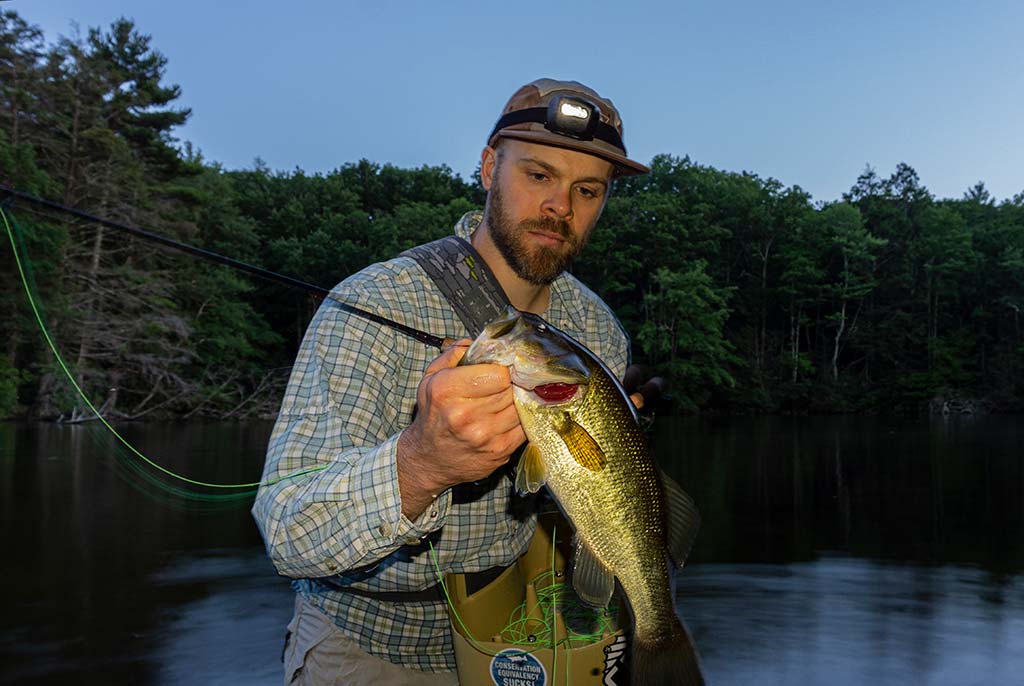Outside the box thinking leads to catching largemouth bass on albie flies.
I really enjoy reading articles by anglers who have adapted techniques used primarily for one species, to be more successful with another. Learning as many techniques as possible allows you to be ready for any scenario, and leveraging secrets from other fisheries can unlock bites you didn’t even know existed. Case in point, I’ve learned so much from reading articles by musky anglers which has helped me become a better striped bass angler. Further, reading Ken Abrames books and writings on using trout techniques for stripers has been hugely influential on how I approach the surf with the fly rod.
Yet, there are species and anglers that seem so far apart as to have almost nothing in common. When I started thinking about this a couple years ago, one of the biggest juxtapositions I could think of was false albacore (albies) and largemouth bass. The techniques, presentations, and even general angler demographics seemed so wildly different between the two species that it seemed impossible there would be any cross over. However, always up for a challenge, I started carrying some albie flies with me when I went bass fishing with the fly rod and found that they work shockingly well. Or, perhaps, not that shocking at all. Once I stopped to think about it, bass will eat just about anything, and albie flies tend to be very life-like and artfully created; more than realistic enough to fool even the wisest of bucket mouths.

One of my preferred flies albie fishermen use is the Mushmouth minnow. Small and medium-sized versions of these flies are great when the albies are on peanuts and slightly larger minnows in the fall, but I use them in freshwater for a variety of species. The Mushmouth is an all-around baitfish imitator, and they present a really nice profile from all angles. These are a classic example of a fly where the water is the final bit of material. That is, the fish don’t see the space between the fibers, but instead see a full profile as created by the materials, which is filled out by the water. These flies are easy to cast, and while I am almost always using an eight-weight these days for bass, you can cast a size 1/0 Mushmouth with a five- or six-weight rod. Also, Mushmouth are tied with tough, synthetic materials and this makes them last a long time, and they are inexpensive to buy or make. Finally, I like to fish these flies on a floating line, and can work them slow, without having them sink right to the bottom. This makes them great over shallow flats and when I’m tossing them right tight up to the shoreline. A true win-win-win fly, and one of my favorites.
Another albie fly I like to use for largemouth is the Surf Gummy. This is a hyper realistic fly that can fool even the pickiest of fish. In larger sizes, it actually provides a pretty good profile, too. In the bass pond, I fish it with hard, rapid jerks and then let it sink. This “snap” stripping makes it look like an injured or dying minnow, and the rapid movement induces reactionary strikes from bass. You just have to be careful with these flies as they do tend to sink faster than many other flies used in freshwater (that aren’t a jig fly). Whenever I fish these, I can’t help but think about the old Banjo Minnow commercials that were always on TV when I was a kid; the way I fish these flies is very similar.
Finally, there’s always the Crease fly. This is a little bit cheating, as the Crease is used for all kinds of species in the Northeast and beyond. It’s an excellent alternative to a popper on those really calm mornings when a big, loud popper is too much. They’re really great for skittering along the edges of lily pads, and tossing right up against the shore.
The Mushmouth, Surf Gummy, and Crease flies aren’t the only albie flies I use, and I challenge you this fall to think about what flies and lures you can use to cross over between species. While I don’t believe that “a fish is a fish”, I do believe there is a lot of unlocked potential yet to be explored between species for the savvy Northeast fishermen.



